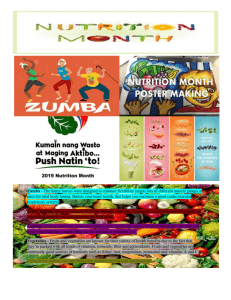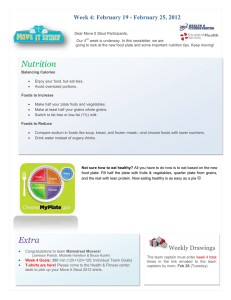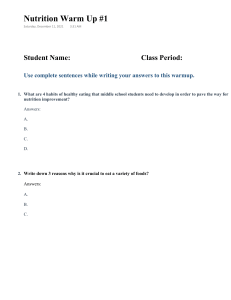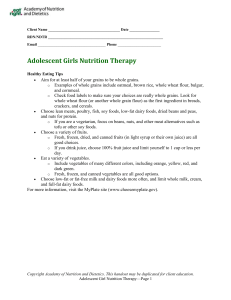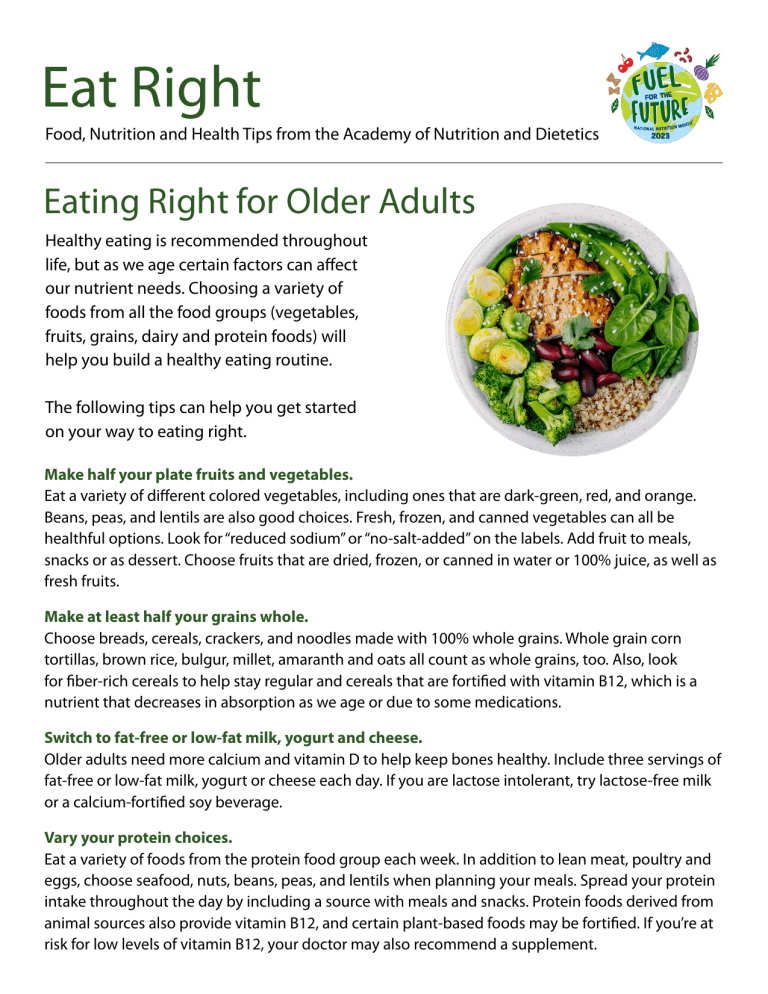
Eat Right Food, Nutrition and Health Tips from the Academy of Nutrition and Dietetics Eating Right for Older Adults Healthy eating is recommended throughout life, but as we age certain factors can affect our nutrient needs. Choosing a variety of foods from all the food groups (vegetables, fruits, grains, dairy and protein foods) will help you build a healthy eating routine. The following tips can help you get started on your way to eating right. Make half your plate fruits and vegetables. Eat a variety of different colored vegetables, including ones that are dark-green, red, and orange. Beans, peas, and lentils are also good choices. Fresh, frozen, and canned vegetables can all be healthful options. Look for “reduced sodium” or “no-salt-added” on the labels. Add fruit to meals, snacks or as dessert. Choose fruits that are dried, frozen, or canned in water or 100% juice, as well as fresh fruits. Make at least half your grains whole. Choose breads, cereals, crackers, and noodles made with 100% whole grains. Whole grain corn tortillas, brown rice, bulgur, millet, amaranth and oats all count as whole grains, too. Also, look for fiber-rich cereals to help stay regular and cereals that are fortified with vitamin B12, which is a nutrient that decreases in absorption as we age or due to some medications. Switch to fat-free or low-fat milk, yogurt and cheese. Older adults need more calcium and vitamin D to help keep bones healthy. Include three servings of fat-free or low-fat milk, yogurt or cheese each day. If you are lactose intolerant, try lactose-free milk or a calcium-fortified soy beverage. Vary your protein choices. Eat a variety of foods from the protein food group each week. In addition to lean meat, poultry and eggs, choose seafood, nuts, beans, peas, and lentils when planning your meals. Spread your protein intake throughout the day by including a source with meals and snacks. Protein foods derived from animal sources also provide vitamin B12, and certain plant-based foods may be fortified. If you’re at risk for low levels of vitamin B12, your doctor may also recommend a supplement. Limit sodium, saturated fat and added sugars. Look out for salt, or sodium, in foods you eat. Compare sodium in the foods you buy and choose those with lower amounts. Add spices or herbs to season food without adding salt. Switch from solid fats to oils when preparing foods. Make major sources of saturated fats occasional choices, not everyday foods. Examples of these include desserts, fried foods, pizza, and processed meats like sausages and hot dogs. Select fruit for dessert more often in place of treats with added sugars. Stay well-hydrated Drink plenty of water throughout the day to help prevent dehydration and promote good digestion. Other beverages that can help meet fluid needs include unsweetened beverages, like low-fat and fat-free milk, fortified soy beverages, and 100-percent fruit juices. Choose these more often in place of sugary drinks. Enjoy your food but be mindful of portion sizes. Most older adults need fewer calories than in younger years. Avoid oversized portions. Try using smaller plates, bowls and glasses. Cook more often at home, where you are in control of what’s in your food. When ordering out, look for dishes that include vegetables, fruits and whole grains, along with a lean protein food. When portions are large, share a meal or save half for later. Consult a registered dietitian nutritionist if you have special dietary needs. A registered dietitian nutritionist can create a customized eating plan for you. For a referral to a registered dietitian nutritionist and for additional food and nutrition information, visit eatright.org. This tip sheet is provided by: The Academy of Nutrition and Dietetics is the world’s largest organization of food and nutrition professionals. The Academy is committed to improving health and advancing the profession of dietetics through research, education and advocacy. Authored by Academy of Nutrition and Dietetics staff registered dietitian nutritionists. Sources: U.S. Department of Health and Human Services and Complete Food and Nutrition Guide, 5th edition ©Academy of Nutrition and Dietetics. Reproduction of this tip sheet is permitted for educational purposes. Reproduction for sales purposes is not authorized.
